Cat Tail Language: What Your Cat’s Tail Is Telling You
The post Cat Tail Language: What Your Cat’s Tail Is Telling You by Ellyce Rothrock appeared first on Catster. Copying over entire articles infringes on copyright laws. You may not be aware of it, but all of these articles were assigned, contracted and paid for, so they aren't considered public domain. However, we appreciate that you like the article and would love it if you continued sharing just the first paragraph of an article, then linking out to the rest of the piece on Catster.com.
People who say cats aren’t very expressive and are impossible to gauge just don’t have a clue. A cat’s ears, eyes, body posture and, in particular, her tail, express exactly what she’s thinking and how she’s feeling. You just have to “listen” to cat tail language.
“Since cats are such different animals from us, understanding how they communicate isn’t something that comes naturally to humans,” says Kelly C. Ballantyne, D.V.M., D.A.C.V.B., clinical assistant professor at the University of Illinois College of Veterinary Medicine in Urbana-Champaign. “It is important that all cat owners take the time to learn because understanding how cats communicate helps us to understand them better. Once we know their body language, we can read their emotions, identify situations that cause them distress or pleasure and even identify an illness sooner.”
Once you take the time to learn and understand cat tail language and realize that careful study of cat tail signs is vital to both your and your pet’s happiness in the home, you’ll be amazed at the myriad — and very clear — signals and emotions your feline companion shares with you.
Cat tail language: The basics
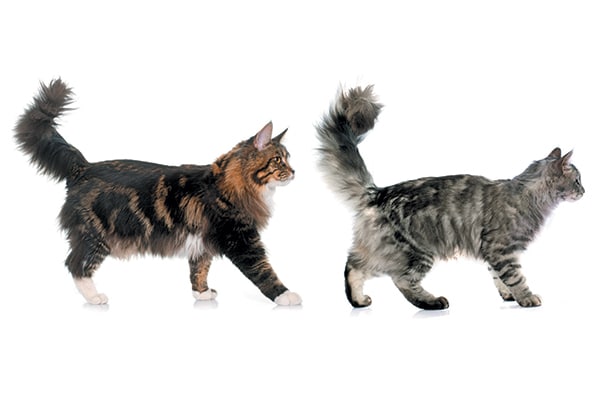
What is your cat’s tail trying to tell you? Photography ©Cynoclub | Thinkstock.
Thankfully, animal behaviorists like Dr. Ballantyne have done exhaustive research to help guide pet owners to understand the finer points of cat tail language.
“Tails can move quickly or slowly,” she says. “A flicking or lashing tail signals that the cat is agitated, while a slowly waving tail indicates the cat is focused on something (i.e., about to pounce on a toy). “The tail-up posture — tail straight up with a slight curve at the end — is a signal that the cat is approaching amicably,” Ballantyne continues. “This posture, witnessed among feline friends, is a common way cats greet their humans.
“Cats may curve their tail around people they are bonded to and may intertwine their tails with other cats they’re bonded to. This is called an affiliative behavior.”
“Cats tuck their tails under or next to their body when they are feeling frightened. They often are crouching with their heads tucked in at the same time. We also can see these behaviors when they’re feeling pain.”
But learning cat tail language is like learning any foreign language: It takes time. If you are new to cat tail signs, you can be confused by what various tail movements and positions indicate and inadvertently upset or confound your cat.
Petting your cat around the tail area
While learning cat tail language is a must for cat owners, actually petting the cat around the area of the tail (the base of the tail or the tail itself) is not appreciated by most cats, Ballantyne says. Rather, focus all petting and scratching around the chin and ears, she adds.
Further, if during a petting session your cat’s tail starts twitching or lashing, her ears are turning back or she’s leaning away from you, these all are signals that your companion is done with this interaction, Ballantyne explains. Cats share pretty clear messages about how they’re feeling at any given moment with one of their most expressive body parts. If you take the time and effort to learn cat tail language, you’ll be talking tail like an expert in no time, bringing you and your feline companion’s relationship to greater understanding and happiness.
How to respond to cat tail language
1. Tail position: Upright, held high
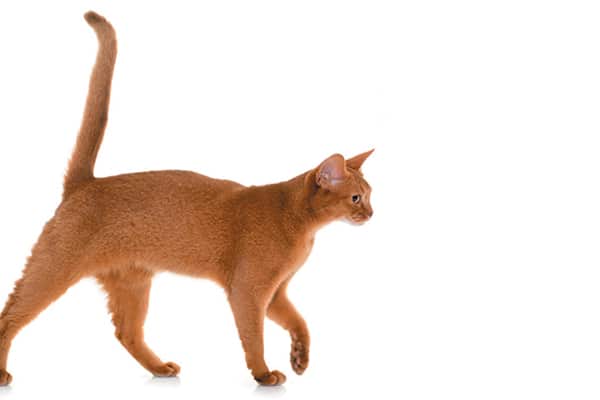
A cat with an upright tail. Photography ©Seregraff | Thinkstock.
2. Tail position: Curled at the top like a question mark
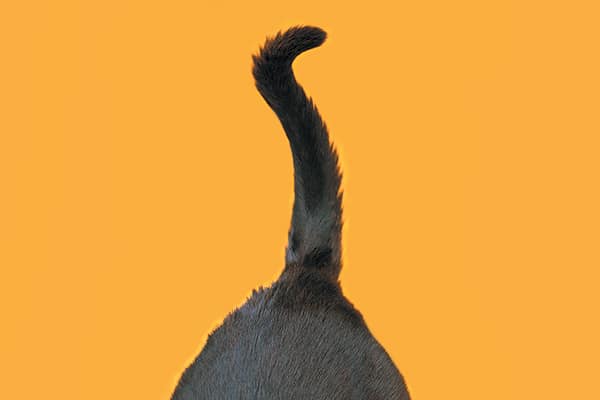
A cat tail curled at the top. Photography ©Photodisc | Thinkstock.
-
- What it means in cat tail language: Friendly
- How you should act/react: Offer your hand for sniffing and petting.
3. Tail position: Straight down
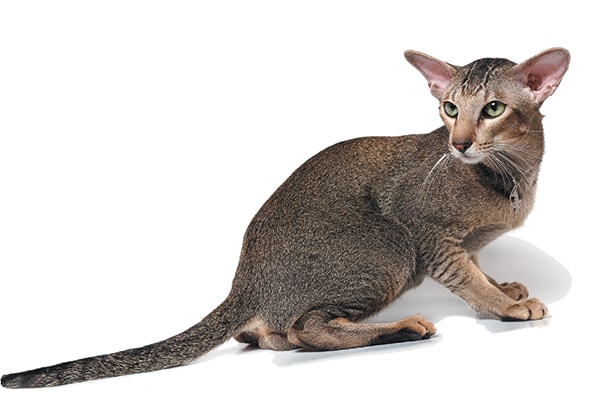
A cat with his tail down. Photography ©Ekaterina Cherkashina | Thinkstock.
- What it means in cat tail language: Agitated, feeling aggressive
- How you should act/react: Don’t try to engage or pet her. Try to neutralize whatever is upsetting her.
4. Tail position: Curved beneath the body
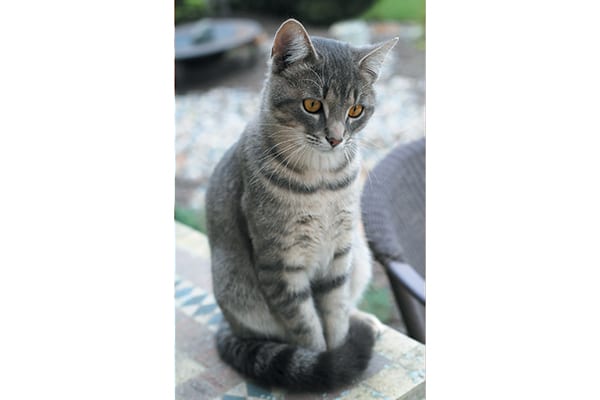
A cat with a curved tail. Photography by ©sakinder | Thinkstock.
- What it means in cat tail language: Nervous and/or submissive
- How you should act/react: Act nonchalant. Wait for her to come to you.
5. Tail position: Puffed
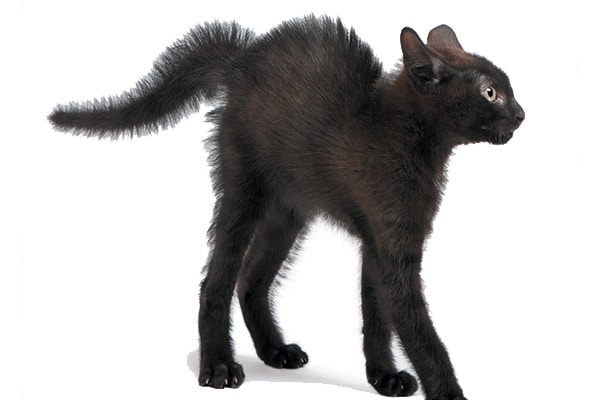
A cat with a puffed tail. Photography ©GlobalP | Thinkstock.
- What it means in cat tail language: Scared, agitated, angry
- How you should act/react: Leave her alone!
6. Tail position: Whipping back and forth
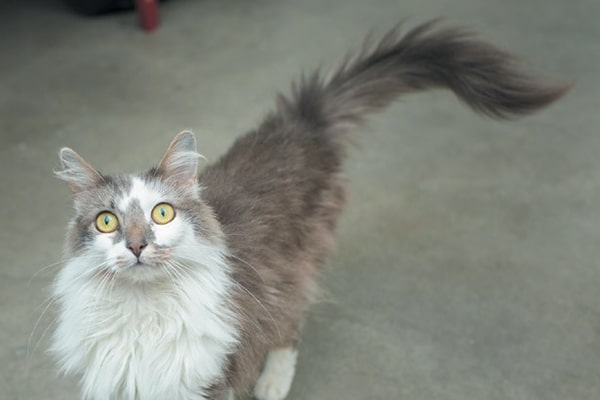
A cat with a whipping tail. Photography by Casey Elise Photography.
- What it means in cat tail language: Fearful; angry, aggressive
- How you should act/react: Best not try for quality snuggle time with an angry cat.
7. Tail position: Swaying slowly from side to side/twitching
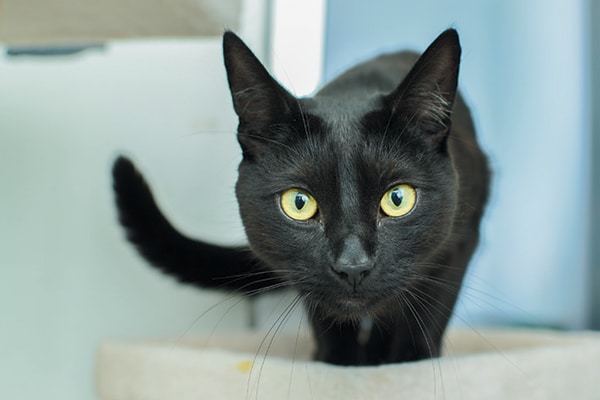
A cat with a swaying tail. Photography by Casey Elise Photography.
- What it means in cat tail language: Focused
- How you should act/react: Let your captivated cat follow her interests.
The table guide to cat tail language
| If a cat’s tail is… | … it means he or she is |
|---|---|
| Upright | Content |
| Up at a 45-degree angle | Unsure |
| Angled back, moving back and forth | “Good” excited or “fearful” excited (the ears and eyes can help determine which) |
| Upright, moving back and forth slightly | Happy |
| Upright, tip bent | Friendly |
| Straight, almost level with the spine | Uneasy; not necessarily afraid |
| Hanging down, with a dip near the base | Aggressive |
| Quickly swishing back and forth | Angry |
| Puffed | Frightened |
| Down at a 90-degree angle | Attack mode |
| Tucked between the legs | Scared, possibly experiencing pain |
| Sitting upright, tail tip is moving | Alert, interested |
Tell us: Did we miss any cat tail signals? How does your cat talk to you in cat tail language?
Thumbnail: Photography ©Tomwang112 | Thinkstock.
This piece was originally published in 2018.
About the author
Ellyce Rothrock spent half her life with Flea, a Maine Coon who lived to be 21 and is missed every single day. She’s currently seeking a feline friend to manage Fritz and Mina, her German Shepherd Dog rescues. She’s lucky enough to live her passion for pets as a 25-year member of the pet media industry.
Editor’s note: Have you seen the new Catster print magazine in stores? Or in the waiting area of your vet’s office? Click here to subscribe to Catster and get the bimonthly magazine delivered to your home.
Read more about understanding cats on Catster.com:
- 9 Weird Cat Sounds and What They Mean
- 6 Cat Meow Sounds and What They Mean
- 10 Common Cat Noises — and What They Mean
The post Cat Tail Language: What Your Cat’s Tail Is Telling You by Ellyce Rothrock appeared first on Catster. Copying over entire articles infringes on copyright laws. You may not be aware of it, but all of these articles were assigned, contracted and paid for, so they aren't considered public domain. However, we appreciate that you like the article and would love it if you continued sharing just the first paragraph of an article, then linking out to the rest of the piece on Catster.com.




Post a Comment